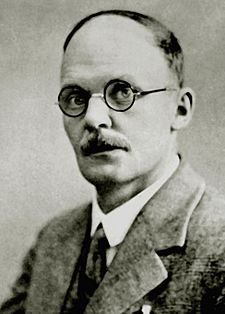Hans Geiger facts for kids
Quick facts for kids
Hans Geiger
|
|
|---|---|

Hans Wilhelm Geiger (1928)
|
|
| Born | 30 September 1882 |
| Died | 24 September 1945 (aged 62) |
| Nationality | German |
| Known for |
|
| Awards |
|
| Scientific career | |
| Fields | Physics and sciences |
| Institutions |
|
| Influences |
|
Johannes Wilhelm "Hans" Geiger (born September 30, 1882 – died September 24, 1945) was a German physicist. He is famous for helping to invent the Geiger counter. This device detects tiny particles that come from atoms.
Geiger also played a key role in the Geiger–Marsden experiment. This important experiment helped scientists discover the atomic nucleus, which is the tiny center of an atom. His brother, Rudolf Geiger, was a meteorologist who studied weather.
Contents
Early Life and Education
Hans Geiger was born in Neustadt an der Haardt, Germany. He was one of five children. His father, Wilhelm Ludwig Geiger, was a professor at the University of Erlangen.
In 1902, Hans Geiger began studying physics and mathematics at the University of Erlangen. He earned his doctorate degree in 1906. His main research was about how electricity moves through gases.
Working with Ernest Rutherford
After finishing his studies, Geiger received a special scholarship. This allowed him to work at the University of Manchester in England. He first worked as an assistant to Arthur Schuster.
In 1907, Arthur Schuster retired. Geiger then started working with the famous scientist Ernest Rutherford. Together, they made very important discoveries about atoms.
The Gold Foil Experiment
In 1908, Geiger and his student Ernest Marsden performed a famous experiment. It is known as the Geiger–Marsden experiment, or sometimes the "gold foil experiment." They shot tiny particles, called alpha particles, at a very thin piece of gold foil.
This experiment helped them count the alpha particles. It also showed that most of the particles went straight through the foil. But some bounced back. This surprising result made Rutherford realize that atoms must have a tiny, dense center. This center is what we now call the atomic nucleus.
Geiger–Nuttall Law
In 1911, Geiger worked with John Mitchell Nuttall. They discovered the Geiger–Nuttall law. This law helps predict how quickly certain atoms decay. Their experiments also helped develop Rutherford's atomic model. This model describes the atom with a small, dense nucleus and electrons orbiting around it.
Career and Discoveries
In 1912, Geiger returned to Germany. He became the head of radiation research at a science institute in Berlin. There, he worked with other important scientists. These included Walter Bothe and James Chadwick, who both later won Nobel Prizes.
Geiger's work was paused during World War I. He served in the German military as an artillery officer from 1914 to 1918.
Confirming the Compton Effect
After the war, Geiger continued his research. In 1924, he used his special device to confirm the Compton effect. This effect shows how X-rays or gamma rays lose energy when they hit electrons. This confirmation helped Arthur Compton win the Nobel Prize in Physics in 1927.
The Geiger–Müller Tube
In 1925, Geiger started teaching at the University of Kiel. In 1928, he and his student Walther Müller made a big improvement to his particle detector. They created the Geiger–Müller tube.
This new device was much better. It could detect not only alpha particles but also beta and gamma particles. The Geiger–Müller tube is the main part of what we now call the Geiger counter.
Later Research
In 1929, Geiger became a professor at the University of Tübingen. There, he made the first observations of a cosmic ray shower. Cosmic rays are high-energy particles that come from space.
In 1936, he moved to the Technical University of Berlin. He continued to study cosmic rays, nuclear fission (when an atom's nucleus splits), and artificial radiation until he passed away in 1945.
World War II and Later Life
From 1939, after the discovery of atomic fission, Geiger was part of the Uranium Club. This was a German group that studied nuclear weapons during World War II. The group later split up in 1942. They thought nuclear weapons would not be important in ending the war.
Geiger lived through the Battle of Berlin at the end of the war. He also experienced the Soviet occupation in 1945. A few months later, he moved to Potsdam. He died there in September 1945, shortly after the atomic bombings in Japan.
See also
 In Spanish: Hans Geiger para niños
In Spanish: Hans Geiger para niños
- Geiger (crater)
- Geiger tube telescope

